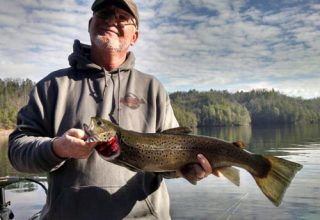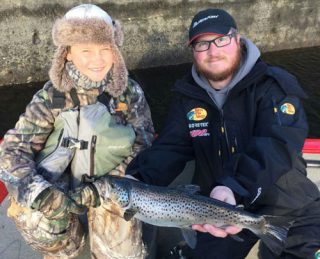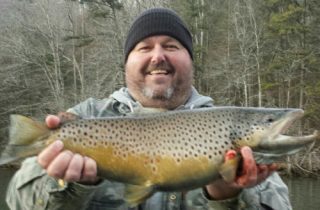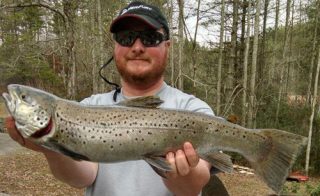While the foundation of my guide service is fishing for trophy smallmouth and spotted bass, I do dabble in, and guide for, other species (crappie, stripers, catfish, bluegill, and trout among them). This month I am going to take a break from the smallmouth and talk about an exceptionally unique fishery: the trophy trout on Apalachia Lake.
In case you are not familiar with the lake, Apalachia is located west of Murphy. It is exceptionally secluded, and is known as a run of river reservoir. It is around 10 miles long and contains about 1,100 acres. Water levels can fluctuate up to 8 feet in a day, and current from Lake Hiwassee just upstream is a huge factor on Apalachia. Current can also severely impact navigation and boat launching/loading, so I always recommend that you fish the lake with someone who knows it before attempting it yourself.

In terms of the fishery itself, the growth rate on the trout has been phenomenal. They have only been in the lake for going on 6 years now, but my personal best is a brown that was just under 10 pounds. I also know of other trout in the 10 pound range that have been caught, and even rumors of a couple of 12 pounders. However, these are exceptional fish. Your average fish on Apalachia will run between 14 and 20 inches, although you could hook into a monster at any time. The best time to fish for them is right now. I have had the most success in the December-March time frame, with the best fishing usually occurring in January and February.


If you are interested in going after a giant trout, smallmouth, spotted bass, striper, or some crappie, give me a call at 865-466-1345. Also, visit us on Facebook@mountainlakesguideservice. We are Murphy, North Carolina’s premier trophy smallmouth and spotted bass guide service, and we offer trips for just about anything else that swims in our area lakes. We look forward to hearing from you!
If you would like to learn some tactics for catching some big winter bass, call Aaron Kephart with Mountain Lakes Guide Service at 865-466-1345, or visit us on Facebook @mountainlakesguideservice. We are Murphy, North Carolina’s premier trophy spotted and smallmouth guide service, and I would love to put you on some winter giants!
